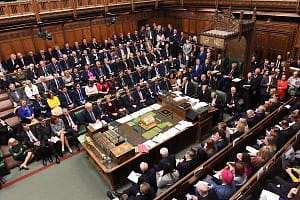Professor Kent Matthews of the Cardiff Business School says extra government spending would be a grave mistake
The calls for Plan B are getting louder. As bad news pours out of the Eurozone giving rise to fears of a double dip recession, there are fears we are cutting too far and too fast.
Spend more, say the advocates of Plan B. But what would a “Plan B” stimulus package do to our economy?
Students of first-year economics are told that a fiscal injection by the government will bring forth an output response that is a multiple of the initial injection. This is what is understood as the Keynesian multiplier. In a recent review of macroeconomic models published in the Journal of Economic Literature it is shown that the fiscal multiplier lies in the range 0.8 to 1.5.
Some new Keynesian models tend to exhibit multipliers of around 0.5 – that is, the government gets 50p expansion in output for £1.00 extra in government spending.
That is hardly a compelling argument for a Plan B. Indeed, recent research published by the National Bureau of Economic Research in the USA suggests that for heavily indebted countries, the multiplier can be as low as zero.
Yet the advocates of Plan B still call for the government to spend more. Use fiscal policy to offset weak private sector demand, the Plan B fans say. Look at the 1930s, they cry.
But what happened in the 1930s? And do the lessons of that decade really promote the idea of a Plan B?
This is not the 1930s
In the 1930s, Britain, like the rest of the world, fell into deep recession. And there are similarities between our age and the 1930s. Sterling was weak then. The UK came off the gold standard in 1931 and Sterling tumbled in value, just as Sterling has tumbled 25 per cent since 2007.
Interest rates were as low then as they could go – the Bank Rate was two per cent from 1933 to 1939 (Treasury Bill Rates were around 0.5 to 0.75 per cent and long-dated gilts between 2.5 to 3.5 per cent). Government debt was high – sky high by today’s standards, at 175 per cent of GDP after the First World War.
There the similarities between the 1930s and today’s economic situation end. Inflation was negative 1934 to 1938 [ed – CPI inflation in the UK stood at five per cent in October 2011]. And there was the traumatic loss of export markets after the War [ed – whereas the UK today is still the world’s seventh largest exporter].
The recovery from the 1930s recession occurred without the aid of fiscal policy. True, the UK economy in the interwar period was a very different animal from what it is now. The government sector was less than half of its current size as a per cent of GDP. (And having a history of being on the gold standard and returning to gold in the second half of the 1920s created a different environment for expectations than the post-second-war history of stop-go and periodic devaluation.)
It is arguable that the economy was at capacity up until 1931 and scope for discretionary policy was minimal until the 30s.
The public sector deficit averaged 1.1 per cent of GDP during the recession period of 1930/33 – small by current standards but viewed widely as damaging to confidence at the time. The position of Britain in the world economy, the use of sterling as a global vehicle currency, and her heavy indebtedness weighed heavily on the thinking of the policy makers.
The key issue in the 1930s was that of capacity. During the 1920s the economy was growing at two per cent, and this was full capacity. There was little scope for fiscal or monetary policy that could have been deployed in any effective manner to reduce unemployment.
Some argue that the current drop in output is permanent, caused by a combination of adverse supply shocks: oil prices, raw material and commodity prices, industrialisation of the far-East and the over-investment in low value-added consumer goods. If the output drop is permanent, then a similar argument applies now as in the 1920s.
So what can we learn from earlier ages?
There is a valid debate to be had about monetary policy. Monetary policy in the 1920s was supporting Britain on the gold standard and a loose monetary policy would have done nothing for growth as the economy was at full capacity. The 30s were different.
After an initial period of shock leaving the gold standard, a policy of cheap money was brought in which had the benefits of increasing private investment, house building and higher consumer spending.
But fiscal orthodoxy was seen as the necessary condition for buying policy credibility and stabilising expectations, particularly after the abandonment of the gold standard. The combination of loose money and tight fiscal policy worked to create the conditions of recovery.
The policy lessons for today depend very much on whether the economy post-2008 is more like the 1920s or the 1930s. If it is like the 1920s, then neither fiscal nor monetary policy would have been effective and only supply-side policy would have had lasting effects on unemployment and productive potential.
If it is like the 1930s, then there is a role for monetary policy but not fiscal policy. Recovery in the 1930s was obtained by offsetting fiscal orthodoxy with cheap money. The 2008 recession is of a deeper magnitude than the recessions of 1980-81 and 1991-2. However, those previous recessions saw output recovering back on to a trend rate of growth of about 2.5 per cent a year, confirming their temporary nature.
At this point in time we don’t know if the Great Recession of 2008 represents a temporary or permanent contraction in capacity.
What should Osborne do now?
There is a debate to be had about monetary policy. If the drop in trend output is temporary, as in the recession of the 30s, then the current policy of fiscal austerity and low interest rates is the correct one. If the drop in trend output is permanent, then fiscal austerity has to be matched with a tightening of monetary policy and loosening of the supply-side through tax cuts and company deregulation. Fiscal austerity is common.
There is no plan B.
Kent Matthews is the Sir Julian Hodge Professor of Banking & Finance at Cardiff Business School. His full report for the IEA can be viewed here.





Leave a Comment